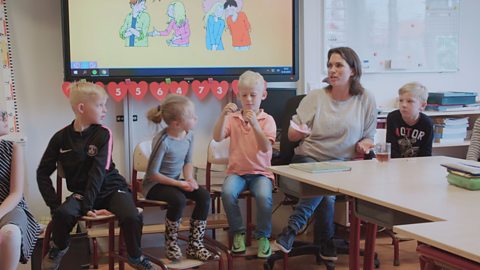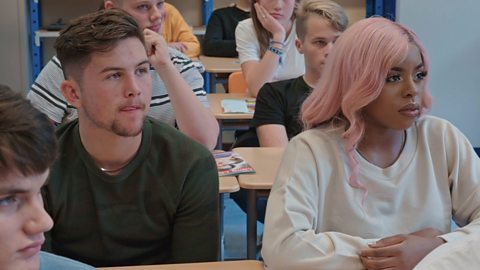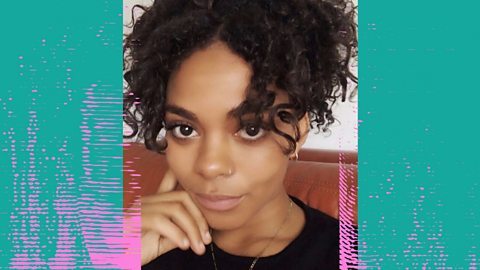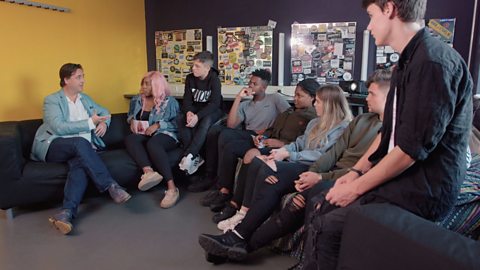Mimi Missfit:
I know it can be embarrassing and I know it can be cringey, but the weird, wonderful world of sex is one that we all need to talk about.
Mimi Missfit:
I'm Mimi Missfit: .
Mimi Missfit:
I'm a YouTuber. I've brought together seven Teenagers: on a fact-finding trip to Holland.
Mimi Missfit:
They're one of the world leaders in sex education, so let's see what us buttoned-up Brits can learn.
TITLE SEQUENCE
Mimi Missfit:
≥ĘĪū≤ű≤ķĺĪ≤Ļ≤‘‚Ķ
Mimi Missfit:
≥“≤Ļ≤‚‚Ķ
Mimi Missfit:
ĶĢĺĪ≤űĪū≥ś≥‹≤ĻĪۂĶ
Mimi Missfit:
į’įý≤Ļ≤‘≤ű≤ĶĪū≤‘ĽŚĪūįý‚Ķ
Mimi Missfit:
Queer or questioning…
Mimi Missfit:
…and others.
Mimi Missfit:
At this Dutch secondary school, the sense of inclusion is very important.
Ms Bakker:
The straight people are always in the majority and you also have the minority, and you have to, yeah, include them also. Our vision is that we want a school that everybody accepts everybody, no matter what you are, if you gay, straight.
Mimi Missfit:
So, this school has a student-run group called the Gender Sexuality Alliance, co-ordinated by Ms Bakker: .
Ms Bakker:
It's something completely in the whole Netherlands and the main aim is giving students a good place to feel free to be themselves.
Mimi Missfit:
While we were in Holland, it was National Coming Out Day, so we celebrated in style.
Mimi Missfit:
Well, thank you, guys, for coming to our party.
Alys:
I identify as pansexual, which people usually assume means that I'm attracted to kitchenware, but that's not correct. How I definite it is that your love is not limited by someone's gender. The party was really fun. It gave me a chance to really express myself. It was just a nice experience to have, because I've never experienced something like that before like ever in my life. [WALLA]
Ms Kee:
How are you guys feeling? I see that you're not really joining in at all.
Munashe:
Yeah. It's not my sort of thing. This is the first drag queen I've seen.
Munashe:
So, I identify straight and, for me, being in the LGBT party was, at first, a bit awkward. I struggled a bit because I didn't fit in with the vibe, so I was just really worried that I was homophobic. After having a chat with the teacher, they just told me like, "It's fine and if you don't like it then you don't like it, there's no problem with that."
Teenagers:
[WHOOP AND CHEER]
Munashe:
Growing up being black, I would like people to respect me for the human I am and not for the skin colour I am, so I thought it's the same for someone else and their sexuality, so I thought I've gotta respect them the way I want to be respected.
Ms Bakker:
It's really important, because you want to give everybody a good feeling when you come to school and don't have to worry about, "Oh, I'm gay," or that somebody makes a fool of you or you're not welcome.
Alys:
I think that since I've come back from Holland I am a lot more open about myself. Schools need to become more willing to educate people.
Alys:
So, at our school I'd like to set up a monthly LGBT club and I'd like to call it Unity. I'd like it to be a place where people of all different sexualities and all different gender identities can come and we can talk about it in like a safe space.
Unknown Female OS:
Well done. [APPLAUSE] Thank you so much.
Alys:
At the end of the day, it's teachers' responsibility to protect their student. The only way we can stop people from being ignorant and making ignorant comments is through educating them.
Munashe:
I think going to Holland definitely made me more open-minded as a heterosexual male. I'll definitely be less shocked the next time I see a drag queen, it'll be normal to me, and I'd like to see what my friends do when they see it. Her. Him. Her, him, who? Who knows? Whatever you want to be!
Video summary
Presenter and YouTuber Mimi Missfit takes a group of seven British teens to Holland to look at how to make schools feel inclusive and welcoming for people of all sexualities.
The acronym LGBTQ+ is introduced (Lesbian, Gay, Bisexual, Transgender, Queer or Questioning, and others).
Ms Bakker is the leader of her school's branch of the nationwide Gender Sexuality Alliance and has a vision of inclusive schools, where it doesn’t matter what sexuality you are, everyone is accepted.
In the Netherlands there is a ‚ÄúNational Coming Out Day‚ÄĚ, and the teens attend a party to celebrate this at the school.
They all get dressed up for the occasion in the colours of the pride flag and dance together and with a drag queen.
Alys identifies herself as pansexual, and gives the definition.
Munashe is not so keen on the National Coming Out Day party, and explains that at first he found the party awkward and worried that he was homophobic, but was reassured by his teachers that it is okay for him not to like it.
Drawing on his experience as a BAME person, Munashe explains that he understands how you need to give people the same respect you expect, regardless of your ethnicity or sexuality.
Alys is inspired by their trip to Holland and sets up a monthly LGBT club ‚ÄúUnity‚ÄĚ at her own school in the UK shortly after her return.
She explains her belief that it’s teachers' responsibility to protect their students and that education will stop ignorance.
Munashe says going to Holland made him more open-minded as a heterosexual male.
This short film is from the ¬ť∂Ļ‘ľŇń series, Mimi on a Mission: Sex Ed. For further episodes please visit the ¬ť∂Ļ‘ľŇń iPlayer.
Teacher Notes
Before watching the film
This short film is suitable for 14-16 year olds however always make yourself familiar with the content and consider carefully whether it will be appropriate and of use for your specific cohort. (every class is different, even if they are in the same year group).
Check your school policies to make sure you follow school guidelines and talk to a member of the SLT (Senior Leadership Team) if in doubt about anything.
Check to see if any of your class have any child protection issues or are vulnerable children.
Once you are confident it is the right resource for your pupils, watch it through alone and consider how it would work best for you all.
This short film might also be useful for teachers to use in CPD sessions (Continuing Professional Development).
During the lesson/watching the film
Set up a working agreement with the class and create a list of ground rules for the session so everyone feels safe and able to talk and join in discussions without being judged. Remember to include a reminder to always talk to a trusted adult if anything in the film makes your students feel uncomfortable ‚Äď perhaps create a list of ‚Äėgo-to‚Äô people in the school with them.
You could start the lesson by discussing the title ‚ÄėTeaching Inclusivity at School‚Äô and using this as a starter. (NB: Discussion can be in pairs, small groups or as a whole class ‚Äď choose what works best for your pupils).
The film shows Mimi with some British teenagers in the Netherlands (one of the world leaders in sex education). Here they visit a secondary school where their sense of inclusion is very important.
It starts with Ms Bakker (a secondary teacher). She says, ‚ÄúThe straight people are always in the majority and you also have the minority and you have to include them also.‚ÄĚ
She goes on to explain that the schools vision is that ‚Äúeverybody accepts everybody, no matter what you are ‚Äď if you‚Äôre gay, straight‚Ķ‚ÄĚ
What do your pupils think of this? Can they think of what the school might do to make this happen?
Alys talks about how she identifies as pansexual. She describes this by saying ‚Äúyour love is not limited by someone‚Äôs gender.‚ÄĚ Do your class know any other sexualities or genders?
Maybe you could spend some time discussing these and understanding them. (*If you decide to do this be sure to do your research thoroughly first and always remember that not everyone conforms to a specific ‚Äėlabel‚Äô so it is always a good idea to ask someone how they identify themselves and never to assume).
Munashe talks about his concerns about being homophobic because he says at first he felt a bit awkward at the LGBTQ+ party. He felt he didn‚Äôt fit in ‚Äúwith the vibes‚ÄĚ so struggled a bit. He felt really worried he was homophobic.
- Do your pupils think he is?
- Why do they think this?
- How would they feel at that party?
He goes on to say; ‚ÄúGrowing up being black, I would like people to respect me for the human I am and not for the skin colour I am so I thought it‚Äôs the same for someone else and their sexuality so I thought I‚Äôve got to respect them the way I want to be respected.‚ÄĚ What do your pupils think about what he says here?
Have an open discussion and maybe let this conversation extend to consider the wider concept of respect.
Ms Bakker goes on to say how important inclusivity is. She says, ‚ÄúYou want to give everybody a good feeling when you come to school and you don‚Äôt have to worry about, ‚Äėoh, I‚Äôm Gay‚Äô, or somebody makes a fool of you or you‚Äôre not welcome.‚ÄĚ Discuss what you all do in your school to promote inclusivity.
Alys reflects ‚Äď she says when she came back from the Netherlands she felt a lot more open about herself. She decided to set up her own LGBTQ+ club called ‚ÄėUnity‚Äô at her school. Could this work in your school? (Maybe pupils could develop this idea and set something similar up).
She goes on to say, ‚ÄúAt the end of the day it‚Äôs teachers' responsibility to protect their students. The only way we can stop people from being ignorant and making ignorant comments is through educating them.‚ÄĚ Do your pupils agree with this?
Maneshe finishes up supporting this when he says he ‚Äú‚Ķnow feels a lot more open minded as a heterosexual male‚Ķ‚ÄĚ
Ask the class:
- How do they think people can be better educated on LGBTQ+ issues in your school? Maybe they could write down their ideas and perhaps these could be shared with SLT and incorporated into the curriculum or school life.
At the end of your session allow time for any questions or further discussion, pull everything together and make sure you allow for some quiet reflection at the end.
Always check in with the group and remind them to talk to someone if anything they have seen or discussed has made them feel uncomfortable and always signpost where they can get further support or information both within and outside of school. ChildLine will talk to people right up to the age of 19 for support and is free to use.
These short films were created in consultation with a PSHE education expert and will fit within:
- Citizenship and PSHE (RSE) in England.
- The Curriculum for Excellence (Health & Wellbeing Education) in Scotland.
- Learning for Life and Work in Northern Ireland.
- Personal and Social Education (PSE) in Wales.
Teaching Them Young. video
A look at how relationships and sex education is taught at a primary school in Holland.

Teaching Relationships and Sex Education Positively. video
A look at how safe sex is taught at a secondary school in Holland, including a demonstration of putting a condom on a plastic penis model.

Teaching Sexting Awareness. video
Mimi and the teens discuss issues around sending nudes (sexting), and the problems it can lead to.

Teaching Porn Awareness. video
Mimi and the teens meet a Dutch sexologist, who talks to them about the realities of porn and what to be aware of.

Őż
Őż